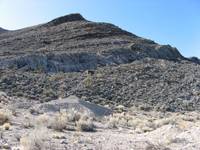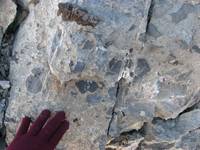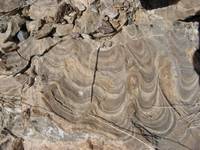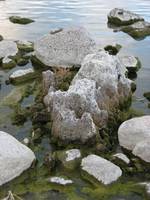The Alamo Breccia: Was it an Impact?
March 28th, 2008 at 10:48 pm (Geology)
 The second day of our Geology 601 field trip led us to the (in)famous Alamo Breccia. A breccia is a rock that contains a bunch of other angular pieces of rock, all jumbled together, and generally forms after something breaks up the original rock and then cements the rubble together. The Alamo Breccia is notable because several researchers have hypothesized that it was created by a massive meteor impact. So out we went in the early, crisp (31 degrees F) Nevada morning to see if we could find the evidence that pointed to this interpretation.
The second day of our Geology 601 field trip led us to the (in)famous Alamo Breccia. A breccia is a rock that contains a bunch of other angular pieces of rock, all jumbled together, and generally forms after something breaks up the original rock and then cements the rubble together. The Alamo Breccia is notable because several researchers have hypothesized that it was created by a massive meteor impact. So out we went in the early, crisp (31 degrees F) Nevada morning to see if we could find the evidence that pointed to this interpretation.
 We started by clambering up to the exposed rock face shown in the top image. And we did find breccia — lots of it (see right)! Some types of evidence for a possible impact were not things we could observe at the outcrop. One such “smoking gun” would be the presence of “shocked” quartz grains, which are grains with many parallel fractures, which could be created by an impact shock wave. This requires a microscope to confirm. Another way that we identify past impacts is by the presence of anomalously high levels of iridium. Iridium is rare in terrestrial rocks, but much more common in meteorites; if one impacted, its debris would leave an iridium signature in the surrounding area. This has been tested in this region, but so far only very low levels of iridium have been observed. However, the researchers in favor of an impact-related explanation for the breccia have also claimed to have found impact-created lapilli, which are little spherical beads of rock that was liquefied and then cooled by the impact. We think we found these (sorry, no picture).
We started by clambering up to the exposed rock face shown in the top image. And we did find breccia — lots of it (see right)! Some types of evidence for a possible impact were not things we could observe at the outcrop. One such “smoking gun” would be the presence of “shocked” quartz grains, which are grains with many parallel fractures, which could be created by an impact shock wave. This requires a microscope to confirm. Another way that we identify past impacts is by the presence of anomalously high levels of iridium. Iridium is rare in terrestrial rocks, but much more common in meteorites; if one impacted, its debris would leave an iridium signature in the surrounding area. This has been tested in this region, but so far only very low levels of iridium have been observed. However, the researchers in favor of an impact-related explanation for the breccia have also claimed to have found impact-created lapilli, which are little spherical beads of rock that was liquefied and then cooled by the impact. We think we found these (sorry, no picture).
 We also found stromatopoloids (see left)! These have nothing to do with the impact hypothesis, except that they are found scattered all around and torn into pieces, so one could argue that something came through and caused the shallow sea environment to change suddenly; other explanations, such as tectonic or volcanic activity, could also apply. These little guys are a kind of sponge, and what you’re seeing is a silicified body fossil, the organism itself. I’m interested due to my current study of stromatolites, which are sedimentary layers that, in some cases, are created as a side effect of bacterial growth. Very similar appearances, but entirely different things. (Am I the only one who thinks this looks weirdly like an astronaut footprint?)
We also found stromatopoloids (see left)! These have nothing to do with the impact hypothesis, except that they are found scattered all around and torn into pieces, so one could argue that something came through and caused the shallow sea environment to change suddenly; other explanations, such as tectonic or volcanic activity, could also apply. These little guys are a kind of sponge, and what you’re seeing is a silicified body fossil, the organism itself. I’m interested due to my current study of stromatolites, which are sedimentary layers that, in some cases, are created as a side effect of bacterial growth. Very similar appearances, but entirely different things. (Am I the only one who thinks this looks weirdly like an astronaut footprint?)
 At our next stop, we found a hydrothermal vein where entirely abiotic stromatolites had formed. See the resemblance, in structure if not color? In this case, no life was involved. We know this because we have petrographic thin sections of this rock, and under the microscope you can see that they’re composed entirely of crystal growth (not bacterial layers). Still, this was another fun collecting frenzy (this is a very important specimen).
At our next stop, we found a hydrothermal vein where entirely abiotic stromatolites had formed. See the resemblance, in structure if not color? In this case, no life was involved. We know this because we have petrographic thin sections of this rock, and under the microscope you can see that they’re composed entirely of crystal growth (not bacterial layers). Still, this was another fun collecting frenzy (this is a very important specimen).
 After lunch, we drove west across Nevada to Hawthorne, and sunset found us at Walker Lake, where abiotic tufa (see left) and carbonate stromatolites are found in abundance. We all stood around and watched while another grad student hacked off pieces of stromatolite for her dissertation research, placing each piece in a sample bag.
After lunch, we drove west across Nevada to Hawthorne, and sunset found us at Walker Lake, where abiotic tufa (see left) and carbonate stromatolites are found in abundance. We all stood around and watched while another grad student hacked off pieces of stromatolite for her dissertation research, placing each piece in a sample bag.
It was another fabulous, full day, and I could barely keep my eyes open through dinner. One more day to go!
Silver Fox said,
March 29, 2008 at 7:33 pm
Interesting post! I’ve lived in Nevada for a long time, love breccias, and have never seen this. Thanks for the photos.